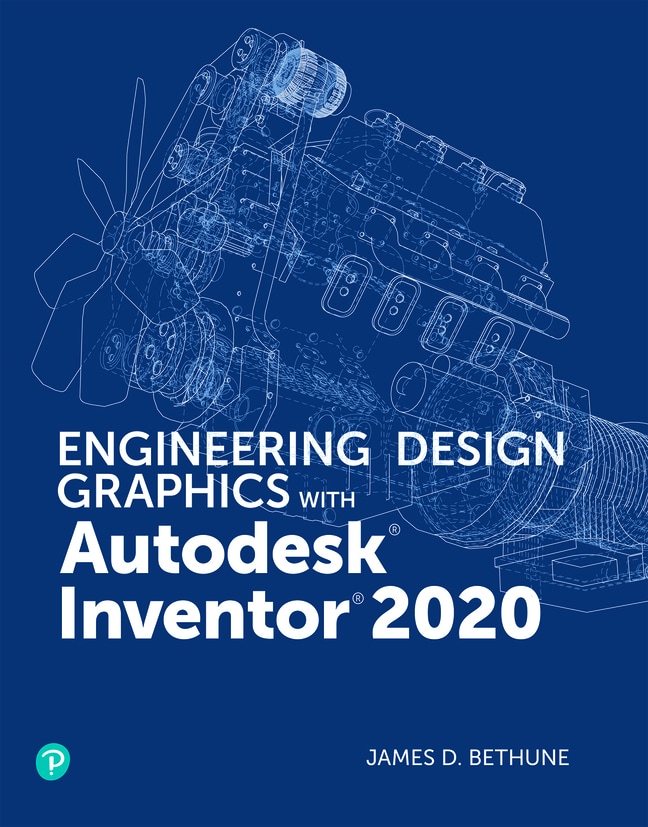
Engineering Design Graphics with Autodesk Inventor 2020, 1st edition
Your access includes:
- Search, highlight, notes, and more
- Easily create flashcards
- Use the app for access anywhere
- 14-day refund guarantee
$10.99per month
Minimum 4-month term, pay monthly or pay $43.96 upfront
Learn more, spend less
-
Listen on the go
Learn how you like with full eTextbook audio
-
Find it fast
Quickly navigate your eTextbook with search
-
Stay organized
Access all your eTextbooks in one place
-
Easily continue access
Keep learning with auto-renew
Overview
1. Get Started
Introduction
Creating a First Sketch
The Undo Tool
Creating a Solid Model
Sample Problem SP1-1
Sample Problem SP1-2 Angular Shapes
Summary
Test Questions
Project
2. Two-Dimensional Sketching
Introduction
The Sketch Panel
Circle
Arc
Spline
Ellipse
Point
Rectangle
Fillet
Chamfer
Polygon
Text
Geometry Text
Dimension
Constraints
Pattern - Rectangular
Pattern - Circular
Pattern - Mirror
Move
Copy
Rotate
Trim
Extend
Offset
Editing a Sketch
Sample Problem SP2-1
Summary
Test Questions
Project
3. 3D Models
Introduction
Extrude
Taper
ViewCube
Revolve
Holes
Fillet
Full Round Fillet
Face Fillet
Creating a Variable Fillet
Chamfer
Face Draft
Shell
Split
Mirror
Rectangular Pattern
Circular Pattern
Sketch Planes
Editing a D Model
Default Planes and Axes
Work Planes
Sample Problem SP3-1
Angled Work Planes
Offset Work Planes
Work Points
Ribs (WEBs)
Loft
Sweep
Coil
Model Material
Summary
Test Questions
Project
4. Orthographic Views
Introduction
Fundamentals of Orthographic Views
Orthographic Views with Inventor
Isometric Views
Section Views
Offset Section Views
Aligned Section Views
Detail Views
Break Views
Auxiliary Views
ASME Y14.3-2003
Summary
Test Questions
Project
5. Assembly Drawings
Introduction
Bottom-Up and Top-Down Assemblies
Starting an Assembly Drawing
Degrees of Freedom
Free Move and Free Rotate Tools
Constrain
Presentation Drawings
Animation
Isometric Drawings
Assembly Numbers
Parts List
Title Block
Subassemblies
Drawing Sheets
Other Types of Drawing Blocks
Top-Down Assemblies
Editing a Part within an Assembly Drawing
Patterning Components
Mirroring Components
Copying Components
Summary
Test Questions
Project
6. Threads and Fasteners
Introduction
Thread Terminology
Thread Callouts - Metric Units
Thread Callouts - ANSI Unified Screw Threads
Thread Representations
Internal Threads
Threaded Blind Holes
Creating Threaded Holes Using the Hole Tool
Standard Fasteners
Sizing a Threaded Hole to Accept a Screw
Screws and Nuts
Types of Threaded Fasteners
Flat Head Screws - Countersunk Holes
Counterbores
Drawing Fasteners Not Included
in the Content Center
Sample Problem SP-
Washers
Setscrews
Rivets
Sample Problem SP-
Summary
Test Questions
Project
7. Dimensioning a Drawing
Introduction
Terminology and Conventions - ANSI
Creating Drawing Dimensions
Drawing Scale
Units
Aligned Dimensions
Radius and Diameter Dimensions
Dimensioning Holes
Sample Problem SP7-1
Dimensioning Counterbored,
Countersunk Holes
Angular Dimensions
Ordinate Dimensions
Baseline Dimensions
Hole Tables
Locating Dimensions
Fillets and Rounds
Rounded Shapes - Internal
Rounded Shapes - External
Irregular Surfaces
Polar Dimensions
Chamfers
Knurling
Keys and Keyseats
Symbols and Abbreviations
Symmetrical and Centerline Symbols
Dimensioning to a Point
Dimensioning Section Views
Dimensioning Orthographic Views
D Dimensions
Sample Problem SP7-2
Sample Problem SP7-3
Summary
Test Questions
Projects
8. Tolerancing
Introduction
Direct Tolerance Methods
Tolerance Expressions
Understanding Plus and Minus Tolerances
Creating Plus and Minus Tolerances
Limit Tolerances
Angular Tolerances
Standard Tolerances
Double Dimensioning
Chain Dimensions and Baseline Dimensions
Tolerance Studies
Rectangular Dimensions
Hole Locations
Choosing a Shaft for a Toleranced Hole
Sample Problem SP8-1
Sample Problem SP8-2
Nominal Sizes
Standard Fits (Metric Values)
Hole and Shaft Basis
Visual Presentations of the Hole and Shaft Tolerances
Standard Fits (Inch Values)
Preferred and Standard Sizes
Surface Finishes
Surface Control Symbols
Geometric Tolerances
Tolerances of Form
Straightness
Straightness (RFS and MMC)
Circularity
Cylindricity
Geometric Tolerances
Using Inventor
Tolerances of Orientation
Datums
Perpendicularity
Parallelism
Angularity
Profiles
Runouts
Positional Tolerances
Virtual Condition
Floating Fasteners
Sample Problem SP8-3
Sample Problem SP8-4
Fixed Fasteners
Sample Problem SP8-5
Design Problems
Summary
Test Questions
Project
9. Springs
Introduction
Compression Springs
Extension Springs
Torsion Springs
Belleville Springs
Springs in Assembly Drawings
Summary
Test Questions
Project
10. Shafts
Introduction
Uniform Shafts and Chamfers
Shafts and Retaining Rings
Shafts and Keys
Square Keys
Pratt and Whitney Keys
Woodruff Keys
Shafts with Splines
Collars
O-Rings
Drawing Shafts and Pins Using the Tools Under the Design Tab
Summary
Test Questions
Project
11. Bearings
Introduction
Plain Bearings
Ball Bearings
Thrust Bearings
Summary
Test Questions
Project
12. Gears
Introduction
Gear Terminology
Gear Formulas
Drawing Gears Using the Gear Tool
Gear Hubs
Gear Ratios
Gear Trains
Gears with Keyways
Gear Assemblies
Supports for Bevel Gears
Worm Gears
Supports for Worm Gears
Summary
Test Questions
Projects
13. Sheet Metal Drawings
Introduction
Sheet Metal Drawings
Flat Patterns
Punch Tool
Summary
Test Questions
Projects
14. Weldment Drawings
Introduction
Fillet Welds
Weldments - Groove Welds
Sample Problem SP14-1
Summary
Test Questions
Project
15. Cams
Introduction
Displacement Diagrams
Drawing a Cam Using Inventor
Sample Problem SP15-1
Cams and Followers
Summary
Test Questions
Projects
Index
16. Projects (Online Only)
- Introduction
- Project : Milling Vise
- Project : Tenon Jig
Appendix (Online Only)
Published by Macromedia Press (May 27th 2021) - Copyright © 2020
ISBN-13: 9780137459315
Subject: General Engineering
Category: Engineering Design
Your questions answered
When you purchase an eTextbook subscription, it will last 4 months. You can renew your subscription by selecting Extend subscription on the Manage subscription page in My account before your initial term ends.
If you extend your subscription, we'll automatically charge you every month. If you made a one‑time payment for your initial 4‑month term, you'll now pay monthly. To make sure your learning is uninterrupted, please check your card details.
To avoid the next payment charge, select Cancel subscription on the Manage subscription page in My account before the renewal date. You can subscribe again in the future by purchasing another eTextbook subscription.
When you purchase a Channels subscription it will last 1 month, 3 months or 12 months, depending on the plan you chose. Your subscription will automatically renew at the end of your term unless you cancel it.
We use your credit card to renew your subscription automatically. To make sure your learning is uninterrupted, please check your card details.